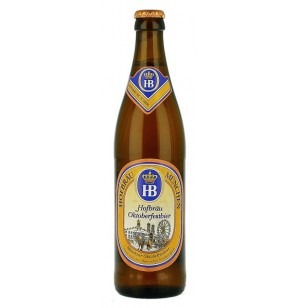Hofbräuhaus Oktoberfestbier clone
Hofbräuhaus Oktoberfestbier clone
(5 gallons/19 L, extract with grains)
OG = 1.062 FG = 1.014
IBU = 23 SRM = 8 ABV = 6.3%
The first Oktoberfest took place in 1810, to celebrate the wedding of the Bavarian prince Ludwig to Princess Therese. All of the people of Munich were invited to celebrate with them in the fields by the front gates of the city. The fields were nicknamed Theresienwiese, or “Theresa’s fields,” in honor of the princess. The festival has been celebrated every year since then. Oktoberfest beers traditionally are brewed in the spring, lagered during the warm summer months and served in September during the annual festival.
Ingredients
1 lb. (0.45 kg) German Munich malt
4 oz. (113 g) Belgian caramel Munich malt
3.75 lbs. (1.7 kg) Muntons extra light dried malt extract
3.3 lbs. (1.5 kg) light liquid malt extract
2 oz. (57 g) maltodextrin powder
4 AAU Tettnanger hops (60 min.) (1 oz./28 g at 4% alpha acids)
3.2 AAU German Hallertau Hersbrucker hops (60 min.) (1 oz./28 g at 3.2% alpha acid)
1 tsp. Irish moss
Munich Lager (Wyeast 2308) or Oktoberfest Lager (White Labs WLP820) yeast
3/4 cup corn sugar (if bottling)
Step by Step
Bring one gallon (3.8 L) of water to 155 °F (68 °C), add crushed grain and hold for 30 minutes at 150 °F (66 °C). Strain the grain into the brewpot and wash grains with one gallon (3.8 L) of 168 °F (76 °C) water. Add the dried and liquid malt extract and bittering hops. Bring the total volume in the brewpot to 3 gallon (11.4 L).
Boil for 45 minutes, then add the Irish moss. Boil for 15 minutes, then remove the pot from the stove. Cool wort for 15 minutes in an ice bath or chill with wort chiller. Strain into fermenter and add water to obtain 5.25 gallons (20 L). Add yeast when wort has cooled to below 68 °F (20 °C). Oxygenate-aerate well.
Start fermentation at 60 to 62 °F (16 to 17 °C) until fermentation begins (approximately 24 hours). Bring primary fermenter to 47 to 52 °F (8 to 11 °C) for 7 days, then rack into secondary (glass carboy). Ferment at 47 to 52 °F (8 to 11 °C) for 4 weeks, then bring the fermenter to 60 to 62 °F (16 to 17 °C) until target gravity has been reached and the beer has cleared (approximately 2 additional weeks). Keg and force carbonate or prime and bottle. If bottling, carbonate the beer at 70 to 72 °F (21 to 22 °C) for 2 to 3 weeks. Store at cellar temperature.
Partial Mash: Acidify the mash water to below 7.2 pH. Mash 1.5 lbs. (0.68 kg) German two-row pilsner malt, 1.5 lbs. (0.68 kg) German Munich malt, 1.5 lbs. (0.68 kg) German Vienna and 4 oz. (113 g) Belgian caramel Munich malt in 1.5 gallons (5.6 L) water at 152 °F (67 °C) for 90 minutes. Sparge with 1.5 gallon (5.6 L) water at 5.7 pH and 168 °F (76 °C). Then follow the extract recipe, omitting 2 lbs. (0.91 kg) Muntons extra-light dry malt extract from the boil.
All-Grain: Acidify the mash water to below 7.2 pH. Mash 8.75 lbs. (4 kg) German two-row pilsner malt, 2.75 lbs. (1.25 kg) German Munich malt, 1.5 lbs. (0.68 kg) Vienna malt and 3 oz. (85 g) Belgian caramel Munich malt in 17 qts. (16 L) of water at 122 °F (50 °C) for 25 minutes then at 152 °F (67 °C) for 90 minutes. Sparge with 5 gallons (19 L) of water at 5.7 pH and 168 °F (76 °C). The total boil time is approximately 90 minutes. Add the Irish moss as indicated by the extract recipe.
This beer will peak between three and seven months after it is carbonated and will last at cellar temperatures for nine months.
Written by Tess and Mark Szamatulski

All the Munich breweries prepare an Oktoberfest for the celebration. The Hofbräuhaus, which means “Royal Court Brewery,” is probably the most famous of the city’s breweries. In fact, the Hofbräuhaus may be the most famous brewery, beer garden and beer hall in the world.
Hofbräuhaus Oktoberfest has a creamy, tight, off-white head and a luscious amber color. The nose is aromatic malt the palate is smooth, with intense malt and nutty, bread-like nuances. The finish is one of semi-sweet malt.


